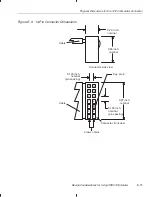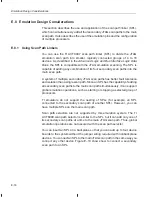
Emulator Cable Pod
E-5
Design Considerations for Using XDS510 Emulator
E.3 Emulator Cable Pod
Figure E–2 shows a portion of the emulator cable pod. The functional features
of the pod are:
-
TDO and TCK_RET can be parallel-terminated inside the pod if required
by the application. By default, these signals are not terminated.
-
TCK is driven with a 74LVT240 device. Because of the high-current drive
(32-mA I
OL
/I
OH
), this signal can be parallel-terminated. If TCK is tied to
TCK_RET, you can use the parallel terminator in the pod.
-
TMS and TDI can be generated from the falling edge of TCK_RET, accord-
ing to the IEEE 1149.1 bus slave device timing rules.
-
TMS and TDI are series-terminated to reduce signal reflections.
-
A 10.368-MHz test clock source is provided. You can also provide your
own test clock for greater flexibility.
Figure E–2. Emulator Cable Pod Interface
100
Ω
TL7705A
RESIN
270
Ω
JP2
180
Ω
TCK_RET (pin 9)
{
EMU1 (pin 14)
EMU0 (pin 13)
74AS1034
GND (pins 4,6,8,10,12)
TRST (pin 2)
TCK (pin 11)
{
10.368 MHz
33
Ω
33
Ω
TDI (pin 3)
TMS (pin 1)
TDO (pin 7)
74LVT240
180
Ω
JP1
270
Ω
74F175
Q
Q
D
PD(VCC) (pin 5)
5 V
5 V
74AS1004
Y
Y
Y
Y
A
† The emulator pod uses TCK_RET as its clock source for internal synchronization. TCK is provided as an
optional target system test clock source.
















































